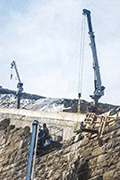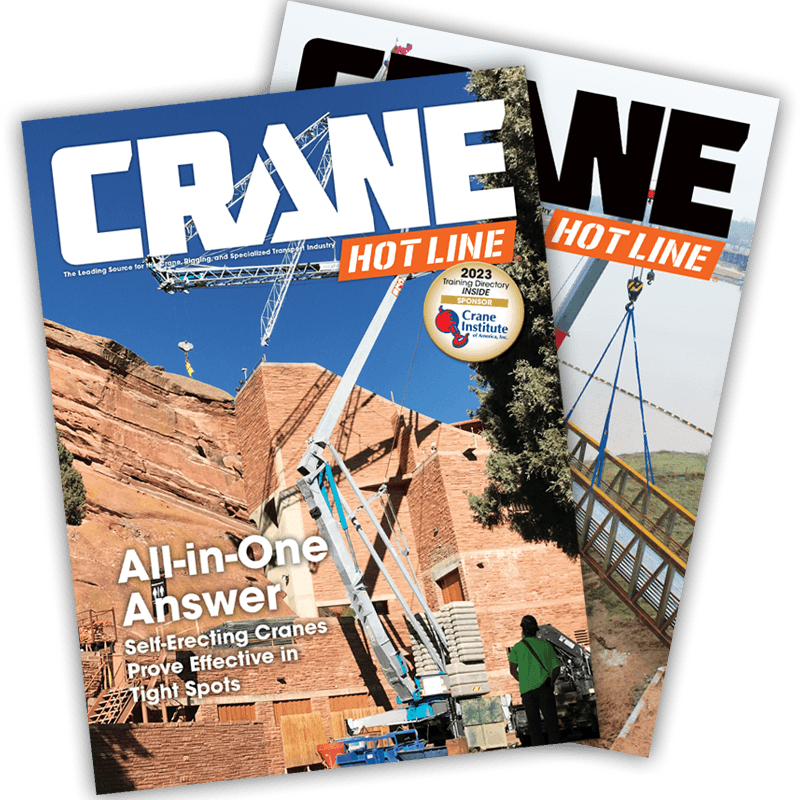IMT Cranes Help Give New York Dam a Facelift
 Gilboa Dam helps form the backbone of New York City’s water-supply infrastructure. Nestled in the Catskill Mountains 125 miles northwest of Lower Manhattan, Gilboa Dam impounds Schoharie Reservoir, a 17.6-billion-gallon basin that accounts for an average of 15 percent of the city’s daily supply.
Gilboa Dam helps form the backbone of New York City’s water-supply infrastructure. Nestled in the Catskill Mountains 125 miles northwest of Lower Manhattan, Gilboa Dam impounds Schoharie Reservoir, a 17.6-billion-gallon basin that accounts for an average of 15 percent of the city’s daily supply.
Ensuring the stability of this nearly 90-year-old dam is critical for delivering plentiful water to America’s most populous city. The New York City Department of Environmental Protection (DEP) recently completed a $400 million, full-scale reconstruction that will enable Gilboa Dam to serve the city for another 50 to 100 years.
Among the finishing touches was a facelift for the weathered training walls. This component of the project presented a special challenge that called for an unusual crane solution.
Challenge set in stone
The Gilboa Dam reconstruction project was a joint venture between D.A. Collins Construction Co. Inc., based in Wilton, New York, and Barnard Construction Company Inc., of Bozeman, Montana.
“We updated the dam and gave it a facelift,” says Craig Valente, P.E., assistant project manager for the Barnard-D.A. Collins Joint Venture (BDJV). “We added mass concrete to strengthen it, and we improved the hydraulics. But there was also a large masonry aspect to this project. The dam had masonry facing on it, and we worked to make the training walls look like the original.”
Decades of weather, water and erosion caused some of the original stones to weaken and dislodge. The DEP contract called for the replacement of the existing deteriorated stone with a new stone façade that would replicate the original look.
BDJV was faced with the logistical challenge of maneuvering 600 new stones up and down a 160-foot wall. Valente says BDJV first considered using one of its massive crawler cranes to set the stones from either below or behind the wall. Each option was deemed infeasible because the approximately 30-by-30-foot footprint of the equipment would interfere with other critical rehabilitation work. Besides, with stones weighing from about 300 to 3,000 pounds, a crawler crane represented “too much crane” for the job.
“We wanted something that was more optimized and economical for the operation,” Valente says. “We determined we didn’t want to use a big crane or a footprint that would hurt our logistics. We started thinking, ‘Can we come up with anything else that can do this work from above?’”
Unusual solution emerges
.jpg) Looking to efficiently maneuver stone and save space on the construction site, BDJV turned to Reading Equipment, a truck equipment distributor based in Bowmansville, Pennsylvania.
Looking to efficiently maneuver stone and save space on the construction site, BDJV turned to Reading Equipment, a truck equipment distributor based in Bowmansville, Pennsylvania.
“We had to get out of the heavy highway contractor mentality and try to think on a smaller scale instead of ‘big job, big equipment,’” Valente says. “We had to think about what we truly needed.”
Reading helped BDJV devise an unconventional solution: telescopic cranes mounted on engineered pedestals anchored atop the spillway and driven by a 49-hp diesel power pack.
The cranes Reading specified were IMT 8600 hydraulic telescopic models from Iowa Mold Tooling Co. Inc. (IMT), a leading manufacturer of mechanics trucks, truck-mounted cranes and other equipment. IMT 8600 cranes are typically found on IMT mechanics trucks serving multiple industries including construction.
Elevated cranes lift efficiency
With 8,600 pounds of lift capacity, 30 feet of hydraulic reach and radio-remote-control operation, the IMT 8600 cranes met the demands of the non-traditional application.
Stones were staged on the back side of the training wall, where one by one they were loaded into a nylon lifting device and easily lowered by the crane operator to masons working in a man lift or on scaffolding. Masons guided and anchored the stone, filled the cavity, and continued moving up the wall.
The radio remote control enabled the crane operator to move around and maintain optimized visibility of the load. It also allowed the operator to precisely “feather” each stone into place, a valuable capability when handling such a heavy object.
Once one section of the wall was topped off with a capstone, the other IMT 8600 crane was used to begin work on the adjacent section. All the while, other work continued unimpeded below and behind the wall.
“We were happy with the size, performance and production of the cranes,” Valente says. “The equipment did the job efficiently, and there were a lot fewer logistical issues than there would have been with a larger crane solution that caused the mason work to overlap with other operations. In a few short months, we were able to restore and improve the aesthetic appearance of the training walls.”
For more information about IMT, visit www.imt.com. IMT is on Facebook at www.facebook.com/iowamoldtooling and YouTube at www.youtube.com/iowamoldtooling.


